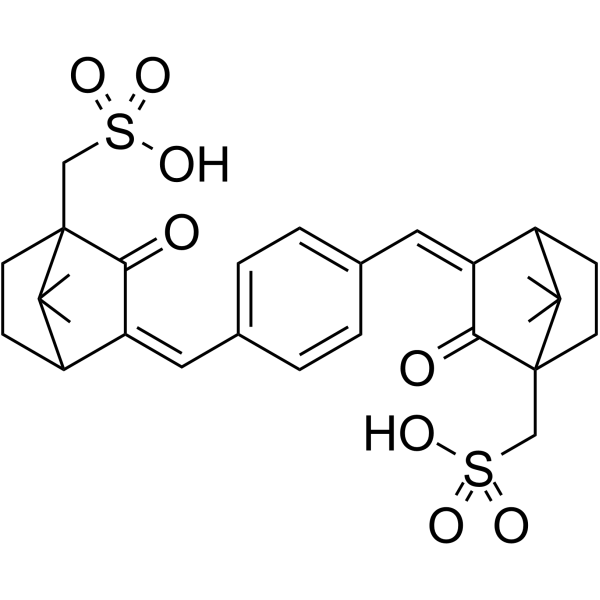ecamsule
Modify Date: 2025-08-21 18:12:05

ecamsule structure
|
Common Name | ecamsule | ||
|---|---|---|---|---|
| CAS Number | 92761-26-7 | Molecular Weight | 562.695 | |
| Density | 1.4±0.1 g/cm3 | Boiling Point | N/A | |
| Molecular Formula | C28H34O8S2 | Melting Point | 255° (dec) | |
| MSDS | Chinese USA | Flash Point | N/A | |
| Symbol |

GHS05 |
Signal Word | Danger | |
Use of ecamsuleEcamsule is a broad-spectrum UVA filter that can be used in sunscreen product. Ecamsule reduces biological damage caused by solar radiation such as pyrimidine dimer formation, p53 protein accumula-tion, or collagenase 2 expression. Ecamsule has the potential for the research of polymorphous light eruption (PMLE) [1] [2]. |
| Name | Ecamsule |
|---|---|
| Synonym | More Synonyms |
| Description | Ecamsule is a broad-spectrum UVA filter that can be used in sunscreen product. Ecamsule reduces biological damage caused by solar radiation such as pyrimidine dimer formation, p53 protein accumula-tion, or collagenase 2 expression. Ecamsule has the potential for the research of polymorphous light eruption (PMLE) [1] [2]. |
|---|---|
| Related Catalog | |
| In Vitro | Ecamsule is a broad-spectrum UVA-absorber with maximum absorbance at 344 nm[1]. Wild-type Fibs E6/E7 cells are more sensitive towards Ecamsule (200-1600 μM) treatment[1]. . Ecamsule counteractes UV and AAPH induced ROS-formation[1]. .The effects are dose-dependent, reaching a maxi-mum ROS reduction by 25.7% at the highest tested concentration of 1600 μM in the UV-setting. With the same concentration of Ecamsule, oxidative stress that had been trigged by AAPH is reduced by 10.8% and basal levels are attenuated by 16.9%[1]. . Ecamsule increases the viability at the highest applied concentration of 1600 μM in the AAPH-treated cells[1]. |
| References |
| Density | 1.4±0.1 g/cm3 |
|---|---|
| Melting Point | 255° (dec) |
| Molecular Formula | C28H34O8S2 |
| Molecular Weight | 562.695 |
| Exact Mass | 562.169495 |
| PSA | 159.64000 |
| LogP | 1.35 |
| Index of Refraction | 1.631 |
| InChIKey | HEAHZSUCFKFERC-UHFFFAOYSA-N |
| SMILES | CC1(C)C2CCC1(CS(=O)(=O)O)C(=O)C2=Cc1ccc(C=C2C(=O)C3(CS(=O)(=O)O)CCC2C3(C)C)cc1 |
| Symbol |

GHS05 |
|---|---|
| Signal Word | Danger |
| Hazard Statements | H318 |
| Precautionary Statements | P280-P305 + P351 + P338 + P310 |
| Hazard Codes | Xi: Irritant; |
| Risk Phrases | 41 |
| Safety Phrases | 26-39 |
| RIDADR | NONH for all modes of transport |
| 3,3'-(1,4-Phenylenedimethylidyne)bis[7,7-dimethyl-2-oxo-bicyclo[2.2.1]heptane-1-methanesulfonic Acid] |
| Mexoryl SX |
| 3,3'-(1,4-Phenylenedimethylidyne)bis(7,7-dimethyl-2-oxobicyclo(2.2.1)heptane-1-methanesulfonic acid) |
| Terephthalylidene-3,3'-dicamphor-10,10'-disulfonic Acid |
| (1,4-Phenylene bis{(Z)methylylidene[(3Z)-7,7-dimethyl-2-oxobicyclo [2.2.1]hept-1-yl-3-ylidene]})dimethanesulfonic acid |
| (1,4-Phenylenebis{(Z)methylylidene[(3Z)-7,7-dimethyl-2-oxobicyclo[2.2.1]hept-1-yl-3-ylidene]})dimethanesulfonic acid |
| Bicyclo[2.2.1]heptane-1-methanesulfonic acid, 3,3'-[1,4-phenylenedi(Z)methylidyne]bis[7,7-dimethyl-2-oxo-, (3Z)- |
